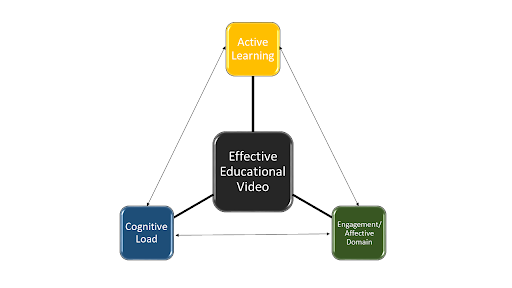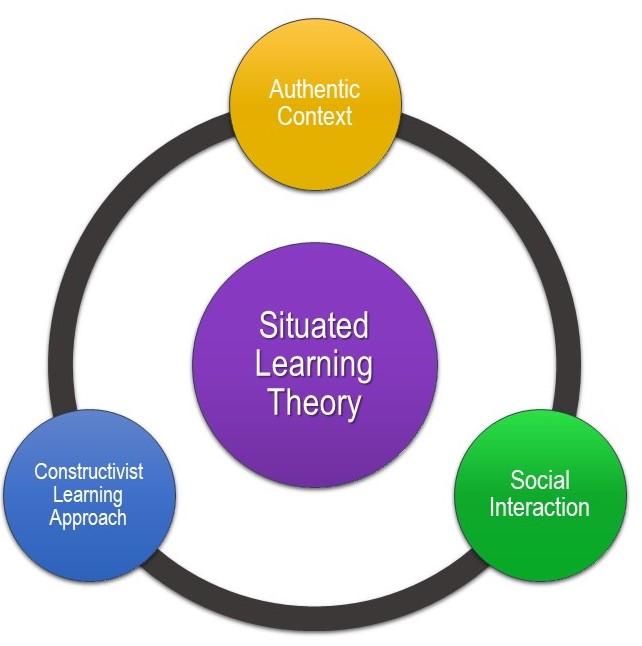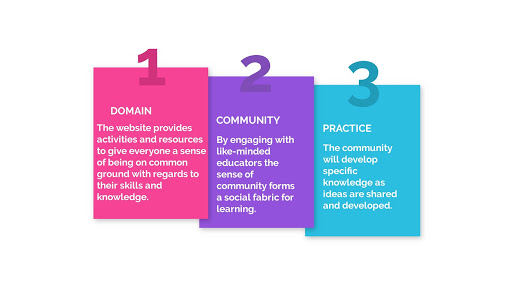As mentioned, this website is designed to introduce people to the process of creating interactive video content. We believe this skill is important as online/blended education is increasingly replacing traditional one-directional lecture styles. One common set back, shared among many instructors and preventing them from implementing more technology in their teaching is their perception that they do not receive enough support and training in creating their own content before being assigned to teach either blended or online courses. This resource acts as a community or support and practice where instructors will have the opportunity to learn and practice the necessary skills needed for video design.
Using Video in Education
Videos, particularly, were chosen as the focus of this resource after considering various studies that show the use of video lectures as better at retaining students’ attention which, in the end, lead to more effective learning outcomes (Brecht, 2012; Thomson, Bridgstock,& Willems, 2014). We hope that by utilizing the resources we have to offer on this site, you will be able to incorporate video content in your teaching in a variety of ways.
The Flipped classroom method is a newly introduced concept that uses both traditional lecture and online learning styles. It moves a more passive centered learning approach outside of the classroom, while encouraging students to engage in problem solving and in-depth conversations with their peers during class time (Abeysekera & Dawson, 2015). The unique characteristics possessed by video content containing both visual and audio help to keep students motivated during learning (Thomson et al., 2014). Additionally, students also have the opportunity to revisit and play back the course content as many times as they need to help master the material.
Creating Effective Learning Experiences
You know that video content can enhance learning, but what makes an effective video in education? According to Brame (2015), there are three elements to take into consideration:
- Cognitive load
- Non-cognitive elements that impact engagement
- Features that promote active learning

Figure 2: Three elements for effective video design and implementation. Adapted from: Brame, C. J. (2015). Effective educational videos.
With only limited working memory capacity, our brains have to select and filter the incoming information and decide what to focus on, before moving from sensory memory to working memory. Because of this, Brame (2015) promoted that video content may be a powerful tool in retaining students’ attention and it is suggested to always consider how much information a student will be exposed to when designing an educational video.
The Cognitive Theory of Multimedia Learning is similar to Cognitive Load Theory illustrating that working memory uses two channels, visual and auditory, which, when used together, working memory’s capacity is maximized. Managing and balancing the load of both channels through video design strategies is a sure way to enhance learning. Furthermore, the cognitive theory of multimedia learning also indicates, similar to constructivist theories, that creating an experience for “meaningful” learning is the most effective way to integrate new information into existing knowledge. Therefore, creating videos that allow the learner to make solid and meaningful connections with the content will be the most effective way to enhance the learning experience.
Moreover, cognitive load plays a vital role when we review the multimedia learning theory which, according to Mayer, 2014, has three instructional design approaches:
- Less is more: pay attention to the specific content and eliminate any “noise” to set a clear focus on the topics
- More is more: make the content more interactive to enhance students’ motivation in learning. The use of interactive video content is a good tool to achieve that.
- Focused more is more: give the opportunity for students to review course content while having the interactive video to stay focused on learning
There are also non-cognitive elements of effective video design that impact student engagement. You need students to watch your videos inorder for them to learn from them. Brame (2015) illustrates a few key considerations when it comes to increasing student engagement through video use. Speaking while using a conversational style and with enthusiasm are two ways to increase student engagement while they watch your videos. Keeping your video as personal as possible (speaking to your students and not getting someone else to speak for you, addressing them personally, speaking like you would in class) is important to consider and has been shown to ensure that your students watch your video from start to finish.
The third and final element of effective video design as discussed by Brame (2015) is the incorporation of active learning strategies. Watching a video can seem like a passive way to acquire knowledge. However, there are a few strategies you should consider in enhancing your video and create a more active learning environment to enhance your students’ learning. Some active learning strategies that you can incorporate into your video include using guiding questions that give the students structure and instruction before and while they watch the video. Kreiner (1997) found that students who were given questions to consider while watching an educational video were more likely to have higher test scores than those who were not given any instructions. Furthermore, there are video editing software that allow you to embed interactive components (like quiz questions) in your video, making the overall watching experience more interactive, leading to more effective learning.
You will have the opportunity to explore different forms of videos and how they can improve the overall learning experience in later sections of this resource.
Creating a Community of Practice
Wenger-Trayner and Wenger-Trayner (2015) suggest, in their definition of the term, that a community of practice is formed by people that are actively taking part in the process of collective learning in a shared space. When visiting our website, you will have the opportunity to interact with other educators who share the same interest, of making interactive video content, as you. There will be several spaces and opportunities for you to share your ideas, projects and questions with other educators on this website. The goal is to foster the creation of a community of practice that will lay the foundation for you to share your knowledge and learn from others.
There are two learning theories that underpin the establishment of Communities of Practice (Jakovljevic & Da Veiga, 2019) that need to be noted:
Situated Learning
Communities of practice draw on the principles of situated learning that suggest knowledge creation is unintentional and takes place through the sharing of knowledge and skills in the physical world as well as through social interaction. Situated learning emphasizes the idea that learning should take place in a similar context as where it will be applied (Lave & Wenger, 1991). If the videos you plan to create are destined for online learning or are to be used in a flipped classroom approach, then what better way to learn about making effective videos for online courses than learning it online? Figure 3 summarizes the important tenets on which Situated learning is based.

Figure 3: Key tenets of situated learning theory. Adapted from Green, C., Eady, M., & Andersen, P. (2018). Preparing quality teachers.
Social Learning Theory
By being able to observe others and their thinking in a Community of Practice, you will be able to model and adapt your own attitudes and knowledge on various subjects. Lave and Wenger (1991) suggest that an apprenticeship style of learning is achieved using this approach as learning occurs by observing more experienced users’ work before applying newly acquired skills and knowledge on your own.
The various activities incorporated into this resource eg. sharing of video projects, discussion forums, participation in an annotated bibliography etc. were designed by taking into account the seven guiding principles proposed by Wenger, McDermott & Snyder (2002) for the successful development of a Community of Practice:
- Activities designed for evolution
- Open dialogue for inside and outside perspectives
- Different levels of participation
- Both public and private community spaces
- Focus of all activities on value
- Familiarity and excitement
- Established rhythm for the community
Furthermore, there are three structural elements of a Community of Practice that have been built into the website using the principles stated above. These elements are illustrated in Figure 4.

Figure 4: The structural elements that form the basis of a Community of Practice on the website.
Affordances
By navigating this website, you will be able to learn more about utilizing appropriate technology in creating interactive video content for courses. Our video tutorials are categorized in different sections to reflect the resources users need at any given content creation stage. You can also interact with others to ask questions, share experiences in effective teaching and learning by participating in the discussion forum and commenting on other people’s videos. Users with various levels of knowledge in technology are welcome to join this website and the shared curiosity of wanting to learn more about creating video content will generate authentic conversations among all users.